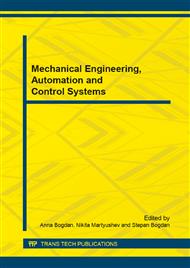[1]
AddNano,: introducing innovative nanotechnology into the value chain of the lubricants market. Press-release. – European funded AddNano Project. (2009).
Google Scholar
[2]
J.M. Martin and N. Ohmae, Nanolubricants, John Wiley and Sons (New-York), (2008).
Google Scholar
[3]
J. Zhou, Z. Wu, Z. Zhang , W. Liu, Q. Xue, Tribological behavior and lubricating mechanism of Cu nanoparticles in oil, Tribology Letters. 8 (2000) 213–218.
Google Scholar
[4]
D. Garkunov, E. Melnikov, V. Gavrilyuk, Tribotechnique, KNORUS. (2011).
Google Scholar
[5]
J. Padgurskas, R. Rukuiza, R. Kreivaitis, S.J. Asadauskas, D. Brazinskiene. Tribologic behaviour and suspension stability of iron and copper nanoparticles in rapeseed and mineral oils, Tribology - Materials, Surfaces&Interfaces. 3 (2009) 97-102.
DOI: 10.1179/175158309x12560424605196
Google Scholar
[6]
Q. He, J. Ye, H. Liu, J. Li. Application of Cu nanoparticles as N32 base oil additives, Front. Mech. Eng. China. 5 (2010) 93–97.
DOI: 10.1007/s11465-009-0083-0
Google Scholar
[7]
D. Singh, J. Routbort, Effects of nanofluids on heavy vehicle systems. Presentation made by Argonne National Laboratory, University of Chicago, to the US Department of Energy. (2006).
Google Scholar
[8]
Y.D. Zhang, J.S. Yan, L.G. Yu, P.Y. Zhang. Effect of Nano-Cu Lubrication Additive on the Contact Fatigue Behavior of Steel, Tribology Letters. 37 (2010) 203–207.
DOI: 10.1007/s11249-009-9515-6
Google Scholar
[9]
Y. Choi, C. Lee, Y. Hwang, M. Park, J. Lee, C. Choi, M. Jung. Tribological behavior of copper nanoparticles as additives in oil, Current Applied Physics. 9 (2009) 124–127.
DOI: 10.1016/j.cap.2008.12.050
Google Scholar
[10]
I. P. Chernov, Yu.P. Cherdantsev, N.N. Nikitenkov, A.M. Lider, Yu.V. Martynenko, A.S. Surkov, and M. Kroening, Effect of hydrogen and helium on the properties of nuclear reactor materials, Bulletin of the Russian Academy of Sciences: Physics. 72 (2008).
DOI: 10.3103/s1062873808070228
Google Scholar
[11]
N.N. Nikitenkov, Yu.I. Tyurin, I.P. Chernov, A.M. Lider, and A.V. Skirnevskii, Radiation-enhanced and thermostimulated hydrogen release from palladium and zirconium, Journal of Surface Investigation. 2 (2008) 440-443.
DOI: 10.1134/s102745100803021x
Google Scholar
[12]
H. Yu, Y. Xu, P. Shi, B. Xu, X. Wang, Q. Liu, Tribological properties and lubricating mechanisms of Cu nanoparticles in lubricant, Trans. Nonferrous Met. Soc. China. 18 (2008) 636-641.
DOI: 10.1016/s1003-6326(08)60111-9
Google Scholar
[13]
Y. Zhao, Z. Zhang, H. Dang, Fabrication and tribological properties of Pb nanoparticles, Journal of Nanoparticle Research. 6 (2004) 47–51.
DOI: 10.1023/b:nano.0000023223.79545.af
Google Scholar
[14]
I.P. Chernov, Yu.P. Cherdantsev, A.M. Lider, N.N. Niketenkov, Yu.V. Martynenko, S.E. Lukonin, and A.K. Gan, Influence of hydrogen and helium implantation on the properties of structural materials, Journal of Surface Investigation. 2 (2008).
DOI: 10.1134/s1027451008020092
Google Scholar
[15]
I.P. Chernov, Y.P. Cherdantsev, A.M. Lider, Y.I. Tyurin, N.S. Pushilina, and S.V. Ivanova, Hydrogen permeability of protective coating formed by electron treatment of zirconium alloys, Journal of Surface Investigation. 4 (2010) 255-261.
DOI: 10.1134/s1027451010020151
Google Scholar
[16]
L. Kolodziejczyk, D. Martıґnez-Martıґnez, T.C. Rojas, A. Fernaґndez, J.C. Sanchez-Lopez, Surface-modified Pd nanoparticles as a superior additive for lubrication, Journal of Nanoparticle Research. 9 (2007) 639-645.
DOI: 10.1007/s11051-006-9124-3
Google Scholar
[17]
S. Ma, S. Zheng, D. Cao, H. Guo, Anti-wear and friction performance of ZrO2 nanoparticles as lubricant additive, Particuology. 8 (2010) 468–472.
DOI: 10.1016/j.partic.2009.06.007
Google Scholar
[18]
G. Liu, X. Li, N. Lu, R. Fan, Enhancing AW/EP property of lubricant oil by adding nano Al/Sn particles, Tribology Letters. 18 (2005) 85-90.
DOI: 10.1007/s11249-004-1760-0
Google Scholar
[19]
H. Shi, X. Fu, X. Zhou and Z. Hu, Preparation of organic fluids with high loading concentration of Ag2S nanoparticles using the extractant Cyanex 301, Journal of Materials Chemistry. 16 (2006) 2097–2101.
DOI: 10.1039/b516917h
Google Scholar
[20]
N.V. Martyushev, I.V. Semenkov, Y.N. Petrenko, Impact of protective release coatings with nanopowders on the quality of bronze castings surface, Advanced Materials Res. 872 (2014) 112-117.
DOI: 10.4028/www.scientific.net/amr.872.112
Google Scholar
[21]
N.V. Martyushev, I.V. Semenkov, Y.N. Petrenko, Structure and properties of leaded tin bronze under different crystallization conditions, Advanced Materials Res. 872 (2014) 89-93.
DOI: 10.4028/www.scientific.net/amr.872.89
Google Scholar
[22]
N.V. Martyushev, I.V. Semenkov, Activation of copper and alumina powders in ball mill, Advanced Materials Res. 872 (2014) 137-141.
DOI: 10.4028/www.scientific.net/amr.872.137
Google Scholar
[23]
I.G. Vidayev, N.V. Martyushev, A.S. Ivashutenko, A.M. Bogdan, The resource efficiency assessment technique for the foundry production, Advanced Materials Res. 880 (2014) 141-145.
DOI: 10.4028/www.scientific.net/amr.880.141
Google Scholar
[24]
N.V. Martyushev, I.V. Semenkov, The possibility of casting surface alloying by nanopowders, Advanced Materials Res. 880 (2014) 272-275.
DOI: 10.4028/www.scientific.net/amr.880.272
Google Scholar


